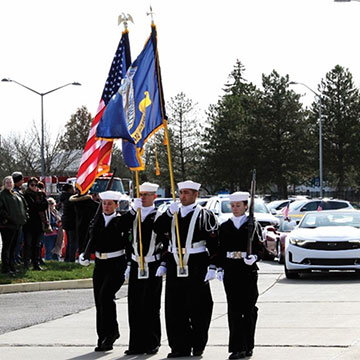Every year on Nov. 11, the United States pauses to collectively honor those who enlisted or commissioned to serve the nation. Some veterans serve for one tour, while others spend decades in uniform. We serve and return to our communities—some silently, some boldly. We are members of your places of worship. We are students returning to university education. We coach your children in Little League. We build small businesses. We live in your neighborhood. But how can you tell a veteran when you see one? We are extremely proud of our years of service and are easily spotted. Veterans may wear black hats emblazoned with military logos, deployments and years served; state license plates are adorned with “Veteran.” Or, maybe we still sport a “high and tight,” the signature military cropped haircut.
Veterans love to connect with others, and they love to tell their stories. Through these stories we hope to build a community that is as connected as the culture of all military branches—Coast Guard, Air Force, Army, Marines, Navy and Space Force. There was a time when nearly every community hosted a parade or ceremony to honor their hometown heroes for Veterans Day. Historically, most civilians had, at least, a peripheral connection with a veteran. But now, many people do not have a personal or familial connection to veterans. Because of this, I encourage everyone to pause, ask questions and listen. Most of us reflect on our time in service very fondly and we know that when we pass on, our stories will too.
Within the Department of Veterans Affairs, every day is Veterans Day. We see the physical and mental toll that military service can have on a person. Often, problems from service manifest years—even decades—after their service ended. That is why the VA’s mission is so important—we thank veterans every day, not just on a holiday. While the how and where of patient care has evolved since VA inception, the one thing that has not changed is U.S. veterans have always been cared for. According to VA history, in 1811, the federal government authorized the first domiciliary and medical facility for veterans. In the late 19th century, the veterans’ assistance program was expanded to include benefits for veterans’ widows and dependents.
What we do at VA goes beyond target demographic markets. Work pioneered by VA researchers continues to enhance not only the lives of veterans, but that of people around the world:
- Established the standard for developing better fitting, lighter artificial limbs through studies of human locomotion, enhanced surgical techniques, and modernized design and manufacturing methods.
- Implanted the first clinically successful implantable cardiac pacemaker. The device was developed in the late 1950s at the Buffalo VA Medical Center.
- Pioneered the first successful liver transplant with a patient living more than a year after surgery.
- Identified the gene associated with a major risk for schizophrenia.
- Showed the effectiveness of a new vaccine for shingles.
- Unveiled the first powered ankle-foot prosthesis, developed in collaboration with researchers at Massachusetts Institute of Technology and Brown University.
- Launched the Million Veteran Program, which establishes one of the world's largest databases of health and genetic information for use in future research aimed at preventing and treating illnesses.
- Invented a wheelchair that allows users to crank up the push rims to a standing position, providing them with increased functionality and independence.
Yes, VA serves veterans, but Americans have also benefited from the research conducted at the 171 VA facilities nationwide, in outlying U.S. territories and the Philippines. We are the largest integrated healthcare system in the U.S.
This Veterans Day, I challenge you all to help spread the word about VA services and benefits. We know there are millions of veterans who are not currently enrolled users of the vast list of benefits created and offered for them, including healthcare. Eligible veterans can use VA services even if they have private insurance. We want all veterans who meet the eligibility criteria to take full advantage of the benefits they have earned though their years in military service and countless sacrifices. With the recent signing of the PACT Act, which expands healthcare to veterans exposed to burn pits and other toxic substances, it is even more important for veterans to understand the benefits that may be available to them. These can be found at www.va.gov/PACT.
Yes, Veterans Day is a holiday—an important one. Many of us have the day off on Nov. 11. If you can, attend a local Veterans Day event. A nonexhaustive list can be found here. But more importantly, connect with a veteran and ask to hear their stories.
Alfred A. Montoya Jr., FACHE, is the senior advisor to the Under Secretary for Health at the U.S. Department of Veterans Affairs, and the ACHE Regent for Veterans Affairs. He is also a veteran of the U.S. Air Force.

